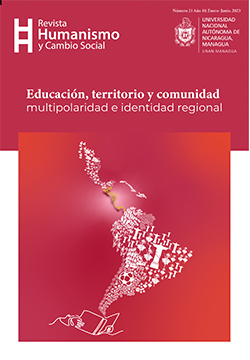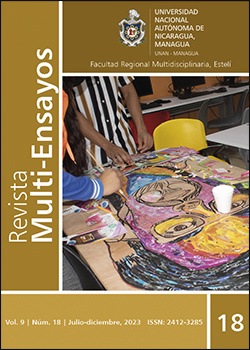El portal de revistas académicas de la Universidad Nacional Autónoma de Nicaragua, Managua (UNAN-Managua) es un espacio de divulgación científica de acceso abierto, que tiene como objetivo organizar, preservar, difundir e internacionalizar la producción intelectual resultante de la actividad investigadora de las distintas revistas de nuestra alma mater.
Revistas
-
Revista Humanismo y Cambio Social
Humanismo y cambio social, es una publicación que busca dinamizar la producción académica basada en las líneas y planes de investigación del área de conocimiento de Ciencias Sociales y Jurídicas. De igual manera, pretende estimular redes académicas, científicas de intercambio y divulgación de los avances, y resultados de proyectos investigativos. Así mismo, es un espacio para la divulgación de las actividades más significativas, de emprendimiento, creación e innovación, realizada por los grupos de trabajo, áreas de interés y departamentos académicos.
-
Raíces: Revista de Ciencias Sociales y Políticas
Raíces: Revista de Ciencias Sociales y Políticas, es una publicación en línea, del Departamento de Ciencias Sociales y Políticas adscrito al área de conocimiento de Ciencias Sociales y Jurídicas de la Universidad Nacional Autónoma de Nicaragua, (UNAN - Managua). En 2023, revista Raíces se convierte en un proyecto académico de carácter multidisciplinario e interdisciplinario como parte de las transformaciones institucionales.
-
REICE: Revista Electrónica de Investigación en Ciencias Económicas
REICE es la revista científica electrónica del Área de Conocimiento de Ciencias Económicas y Administrativas de la UNAN-Managua, tiene una orientación académica investigativa con un exigente proceso de revisión por expertos y es totalmente gratuita. La Revista universitaria REICE acepta la publicación en idioma español e ingles de trabajos de investigación teórica y aplicada, originales y de relevancia que tratan sobre las áreas del conocimiento de la Economía, Contabilidad, Finanzas, Auditoría, Administración y Mercadeo.
-
Revista Multi-Ensayos
La Revista Multi-Ensayos es una publicación semestral e indexada. Surgió en el 2015 desde la Coordinación de Investigación del Centro Universitario Regional, Estelí (CUR-Estelí) en conjunto con los diferentes Departamentos Académicos.
El contenido de la revista presenta experiencias metodológicas del trabajo desarrollado por docentes del CUR-Estelí. Cada ensayo es una descripción y reflexión personal sobre el quehacer docente en las diferentes asignaturas y áreas del conocimiento. Los ensayos analizan los factores que facilitan u obstaculizan el proceso de enseñanza-aprendizaje y las sugerencias que contribuyan a promover cambios y mejoras de los procesos metodológicos desarrollados en el CUR-Estelí.
-
Revista Compromiso Social
La Revista COMPROMISO SOCIAL, surge en el año 2019 con carácter institucional, entre otros tiene como objetivo fundamental en crear espacio de debate, reflexión y diálogo de saberes, para compartir experiencias, visiones, propuestas y resultados del compromiso de esta universidad pública, en la transformación social integral, de nuestras realidades complejas y diversas hacia una sociedad con mayor equidad y justicia social, desarrollo territorial, democratización del conocimiento y acciones universidad-sociedad-estado.
-
Revista Científica Estelí
La Revista Científica Estelí: medio ambiente, tecnología y desarrollo humano, es una publicación electrónica en la web de publicación y acceso gratuito. Es una publicación trimestral y editada por el Centro Universitario Regional de Estelí, UNAN-Managua/CUR-Estelí. Esta revista tiene el propósito de compartir las experiencias de investigación que desarrollan investigadores, docentes y estudiantes.
-
Revista Lengua y Literatura
La Revista de Lengua y Literatura es una publicación semestral del Centro de Investigaciones Lingüísticas y Literarias (CILL) del Departamento de Español de la Universidad Nacional Autónoma de Nicaragua, Managua (UNAN-Managua). Publica en español artículos científicos, ensayos críticos, avances investigativos y reseñas de libros, relacionados con los ámbitos literario, lingüístico y didáctico. Además, se publicará literatura de creación cuando se considere meritorio.
-
Revista Torreón Universitario
Revista Torreón Universitario es la revista académica de publicaciones científicas del Centro Universitario de Carazo (CUR Carazo), que pertenece a la Universidad Nacional Autónoma de Nicaragua, Managua. (UNAN-Managua).
-
Revista Científica Tecnológica - ISSN: 2708-7093
La Revista Científica Tecnológica de UNAN Managua CUR Matagalpa "RECIENTEC", es una publicación electrónica en la web, de periodicidad semestral, editada por la Coordinación de Investigación del Centro Universitario Regional Matagalpa de UNAN Managua. Tiene el propósito de compartir las investigaciones que desarrollan tanto los investigadores de la Facultad como los investigadores de otras universidades y centros de investigación de diferentes países.
Este medio de divulgación Científico está dirigido a los investigadores de las áreas de Educación, Humanidades, Ciencias Económicas y Administrativas, Tecnología, Salud y Agricultura, por ello, se pretende intercambiar la creación intelectual de investigadores en las diferentes temáticas y áreas del conocimiento, promoviendo de manera especial las investigaciones que se llevan a cabo en el CUR-Matagalpa, contribuir en los procesos de investigación a los científicos del habla hispana en la búsqueda de bibliografía relacionada con sus temas de investigación, y también sirviendo como medio de divulgación de resultados de investigaciones en las distintas áreas de ciencia, dado el carácter multidisciplinario de nuestro Centro.
-
Revista Científica Agua y Conocimiento
La Revista Científica Agua y Conocimiento es una publicación electrónica de carácter académico-científico, a través de la cual, el Centro de Investigación de Recursos Acuáticos UNAN-Managua/CIRA, promueve y divulga investigaciones inter, multi y trans - disciplinarias sobre recursos hídricos.
La revista está enfocada en divulgar los trabajos de docentes, investigadores (as), profesionales y estudiantes nacionales e internacionales interesados en los campos de la limnología, calidad y contaminación de agua, sistemas marino-costeros, recursos acuáticos y salud humana, gestión integral de recursos hídricos, cambio climático, quimiometría y gestión de calidad, entre otros.
-
Revista Ciencias de la Salud y Educación Médica
La Revista Ciencias de la Salud y Educación Médica (RCSEM) del Área de Conocimiento Ciencias de la Salud, es una revista electrónica que tiene como objetivo divulgar y difundir la producción científica, innovadora y académica, que se genera en el quehacer de la formación de grado y posgrado de las carreras de la salud, así como un espacio para todos los profesionales de la salud nacionales o internaciones que deseen publicar sus resultados de investigaciones y avances científicos.
-
Revista Tierra
La Revista Tierra (Earth Journal) es una publicación de carácter científico que procura difundir investigaciones realizadas en el campo de la geología, geofísica, hidrología, sísmica, vulcanología, geografía y demás ciencias que estudian la tierra. Con una periodicidad semestral esta revista tiene un enfoque interdisciplinario que se ocupa de la interacción del ser humano con su entorno físico natural; abarca, entre otras, las siguientes temáticas: procesos y riesgos geológicos, hidrogeológicos e hidrológicos, riesgos naturales o antropogénicos, aplicaciones de métodos geofísicos a estudios del medio ambiente, gestión de riesgos de desastres y adaptación al cambio climático.













